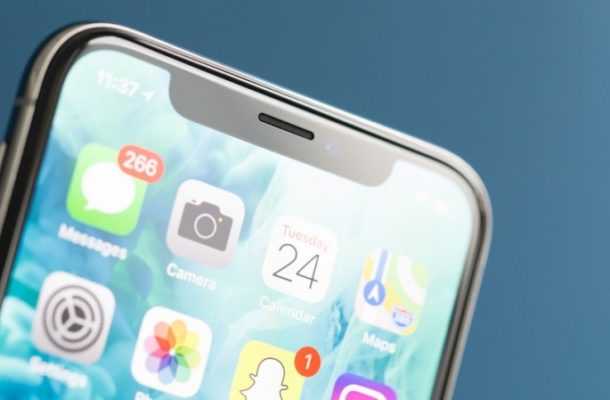Remember how 3D Touch, the iPhone feature where you press harder into the screen, was supposed to be a very big, earth-shattering, game-changing, deal?
Yeah...about that. Apple may finally take the first steps towards abandoning 3D Touch when it releases new iPhones later this year.
KGI Securities analyst Ming-Chi Kuo returned this week with another research note (via MacRumors) for Apple investors. This time, the freakishly-accurate analyst claims Apple will release three iPhones later this year.
All three iPhones will be modeled after the iPhone X (sorry haters, but the Notch is the future) with differing screen sizes, display technologies, cameras, and internal specs, to better cater to a wider range of price points.
Replacing the iPhone X will be a slightly revised version with most of the changes expected to be internal. Kuo's predicting the X will receive a bump in RAM from 3GB to 4GB and a new two-cell L-shaped battery that could have room for up to 10 percent more battery capacity. The A11 Bionic chip will likely get swapped with a faster chip and the screen will remain OLED and measure 5.8-inches.
A larger 6.5-inch "iPhone X Plus" is expected to have all the bells and whistles of the iPhone X, but come with a battery that could be up to 25 percent larger.
Both the X and X Plus should continue to push the value of a $1,000 iPhone, but the most interesting new iPhone might not be the most cutting-edge model.
Kuo says his supply chain checks strongly suggest Apple will introduce a lower-priced and lower-specced iPhone with a screen size that sits in-between the X and X Plus.
The purported 6.1-inch iPhone will mostly resemble an iPhone X with a few differences. It'll reportedly an aluminum frame instead of stainless steel. The rear camera will be a single camera like on the iPhone 8 and not dual cameras.
And — here are the drool-worthy nuggets — the screen will reportedly be an LCD (not OLED) and it won't support 3D Touch.
Going with an LCD screen makes sense — they're cheaper to produce and not as scarce as OLEDs, which are currently only sourced from Samsung. But ditching 3D Touch would be smart, too.
3D Touch was introduced on the iPhone 6S in 2015 as literally a new layer for touchscreens.
"Our team's been hard at work trying to imagine how you take multitouch to the next generation and further deliver a new experience that's just as profound as the first multitouch," said Phil Schiller, Apple's senior vice president of worldwide marketing."3D Touch is a tremendous breakthrough in interacting with our devices."
"Perhaps more than any other system we've designed, 3D Touch is a clear example of how hardware and software, developed together come work to define a singular experience," said Apple chief design officer Jony Ive in his usual voice over.
But as the years rolled by, it turns out 3D Touch isn't as profound as Apple originally thought it would be. 3D Touch is a neat feature, but it's by no means essential to using iOS. You can easily get by without it.
I only started to really appreciate and enjoy using 3D Touch after I forced myself into using it daily and making it a habit. For most people, 3D Touch is little more than a pressure-sensitive right-click that they don't even know exists and have no idea how to use.
Raise your hand if you knew you could 3D Touch on the "X" on your lock screen notifications to clear all your notifications? A lot of people don't, but only because it's not obvious that you can 3D Touch it.
Three years after its intro, there are still many apps that don't have any meaningful 3D Touch shortcut features available when you hard press into their home screen icon or any useful 3D Touch features inside of the app. And I can't even list a single iOS game that supports 3D Touch controls.
3D Touch has the same problem as Force Touch on MacBook trackpads: Nobody's making good use of it.
Which is why Apple might be looking to drop the feature from the 6.1-inch iPhone. And could you blame them? The iPhone X is awfully expensive at $999 and the iPhone X Plus will be priced even higher.
The only way to deliver an affordable iPhone X at a $700-800 price is to make tradeoffs. Cut out the non-essentials. Ditch OLED. Ditch dual cameras. Ditch a stainless steel body. Ditch 3D Touch. The latter requires an added cost to the screen.
As Ive described back at the iPhone 6S launch:
"At its heart are capacitive sensors integrated into the backlight of the Retina HD display. With each press, these sensors measure microscopic changes in the distance between the cover glass and the backlight. These measurements are then combined with signals from the touch sensor and accelerometer to provide fast, accurate continuous response to finger pressure."
Without this extra pressure-sensitive display layer, Apple could finally sell an affordable iPhone X without the $1,000 price tag.
But even if Apple drops 3D Touch from the 6.1-inch iPhone, it won't be the complete end of the feature. 3D Touch will likely still exist on the X and X Plus (assuming Apple doesn't drop on those devices as well). In fact, 3D Touch could live on as a premium feature reserved only for Apple's best and most expensive iPhones.
Apple already employs this strategy with the iPhone SE and its lack of 3D Touch certainly doesn't seem to have hurts sales.
Source: Mashable


Comments